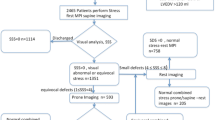Abstract
Objective
Prone thallium-201 (201Tl) myocardial perfusion single-photon emission computed tomography (SPECT) reduces false-positive rates when evaluating inferior wall abnormalities by minimizing diaphragmatic attenuation. The present study investigates the diagnostic validity of prone 201Tl stress myocardial perfusion SPECT for detecting coronary artery disease in the inferior wall of the left ventricle in Japanese patients.
Methods
Of the 104 consecutive patients who underwent 201Tl stress myocardial perfusion SPECT to diagnose coronary artery disease, we evaluated 46 who underwent image acquisition in both the supine and prone positions, and coronary angiography within 3 months thereafter. Images were acquired in the routine supine position immediately following 201Tl (111 MBq) injection and 4 h following early acquisition. Images were acquired in the prone position only during the early phase following supine acquisition. We evaluated the SPECT images of the inferior half segments of the left ventricle using a five-point defect scoring system. According to the coronary angiographic findings, we investigated the diagnostic accuracy of stress-rest supine, stress supine, stress prone, and combined supine-prone images. Reduced uptake in the stress supine image of the combined images was considered as attenuation when uptake was normal in the prone image.
Results
The sensitivity of the stress-rest supine, stress supine, stress prone, and stress-combined supine-prone images was 77%, 86%, 55%, and 55%, and the specificity was 71%, 54%, 79%, and 83%, respectively. Diagnostic accuracy was the highest in stress-rest supine images.
Conclusions
Prone images tended to improve the specificity of detecting coronary artery disease in the inferior wall, but not diagnostic accuracy compared with stress-rest supine images because of decreased sensitivity.
Similar content being viewed by others
References
Tamaki N, Yonekura Y, Mukai T, Kodama S, Kadota K, Kambara H, et al. Stress thallium-201 transaxial emission computed tomography: quantitative versus qualitative analysis for evaluation of coronary artery disease. J Am Coll Cardiol 1984;4:1213–1221.
DePasquale EE, Nody AC, DePuey EG, Garcia EV, Pilcher G, Bredlau C, et al. Quantitative rotational thallium-201 tomography for identifying and localizing coronary artery disease. Circulation 1988;77:316–327.
Esquerre JP, Coca FJ, Martinez SJ, Guiraud RF. Prone decubitus: a solution to inferior wall attenuation in thallium-201 myocardial tomography. J Nucl Med 1989;30:398–401.
DePuey EG. How to detect and avoid myocardial perfusion SPECT artifacts. J Nucl Med 1994;35:699–702.
Lisbona R, Dinh L, Derbekyan V, Novales-Diaz JA. Supine and prone SPECT Tc-99m MIBI myocardial perfusion imaging for dipyridamole studies. Clin Nucl Med 1995;20:647–677.
Perault C, Loboguerrero A, Liehn JC, Wampach H, Gibold C, Ouzan J, et al. Quantitative comparison of prone and supine myocardial SPECT MIBI images. Clin Nucl Med 1995;20:674–684.
Segall GM, Davis MJ. Prone versus supine thallium myocardial SPECT: a method to decrease artifactual inferior wall defects. J Nucl Med 1989;30:548–555.
Kait H, Van Train KF, Friedman JD, Germano G, Silagan G, Wang FP, et al. Quantitative stress-redistribution thallium-201 SPECT using prone imaging: methodologic development and validation. J Nucl Med 1992;33:1509–1515.
Schoss RM, Gorten RJ. Comparison of supine versus prone tomographic myocardial imaging: effect on false-positive rate. Clin Nucl Med 1996;21:445–451.
Dogruca Z, Kabasakal L, Yapar F, Nisil C, Vural VA, Onsel Q. A comparison of Tl-201 stress-reinjection-prone SPECT and Tc-99m-sestamibi gated SPECT in the differentiation of inferior wall defects from artifacts. Nucl Med Commun 2000;21:719–727.
Cerqueira MD, Weissman NJ, Dilsizian V, Jacobs AK, Kaul S, Laskey WK, et al. American Heart Association Writing Group on Myocardial Segmentation and Registration for Cardiac Imaging. Standardized myocardial segmentation and nomenclature for tomographic imaging of the heart: a statement for healthcare professionals from the Cardiac Imaging Committee of the Council on Clinical Cardiology of the American Heart Association. Circulation 2002;105:539–542.
Berman DS, Hachamovitch R, Kiat H, Cohen I, Cabico JA, Wang FP, et al. Incremental value of prognostic testing in patients with known or suspected ischemia heart disease: a basis for optimal utilization of exercise technetium-99m sestamibi myocardial perfusion single-photon emission computed tomography. J Am Coll Cardiol 1995;26:639–647.
DePuey EG, Rozanski A. Using gated technetium-99m-sestamibi for assessment of myocardial perfusion abnormalities. J Nucl Med 1993;34:601–608.
Hendel RC, Berman DS, Cullom SJ, Follansbee W, Heller GV, Kiat H, et al. Multi-center clinical trial to evaluate the efficacy of correction for photon attenuation and scatter in SPECT myocardial perfusion imaging. Circulation 1999;99:2742–2749.
Ho YL, Wu CC, Huang PJ, Tseng WK, Lin LC, Chieng PU, et al. Dobutamine stress echocardiography compared with exercise thallium-201 single-photon emission computed tomography in detecting coronary artery disease-effect of exercise level on accuracy. Cardiology 1997;88:379–385.
Gutman J, Berman DS, Freeman M, Rozanski A, Maddahi J, Waxman A, et al. Time to completed redistribution of thallium-201 in exercise myocardial scintigraphy: relationship to the degree of coronary artery stenosis. Am Heart J 1983;106:989–995.
Author information
Authors and Affiliations
Corresponding author
Rights and permissions
About this article
Cite this article
Katayama, T., Ogata, N. & Tsuruya, Y. Diagnostic accuracy of supine and prone thallium-201 stress myocardial perfusion single-photon emission computed tomography to detect coronary artery disease in inferior wall of left ventricle. Ann Nucl Med 22, 317–321 (2008). https://doi.org/10.1007/s12149-008-0118-3
Received:
Accepted:
Published:
Issue Date:
DOI: https://doi.org/10.1007/s12149-008-0118-3




